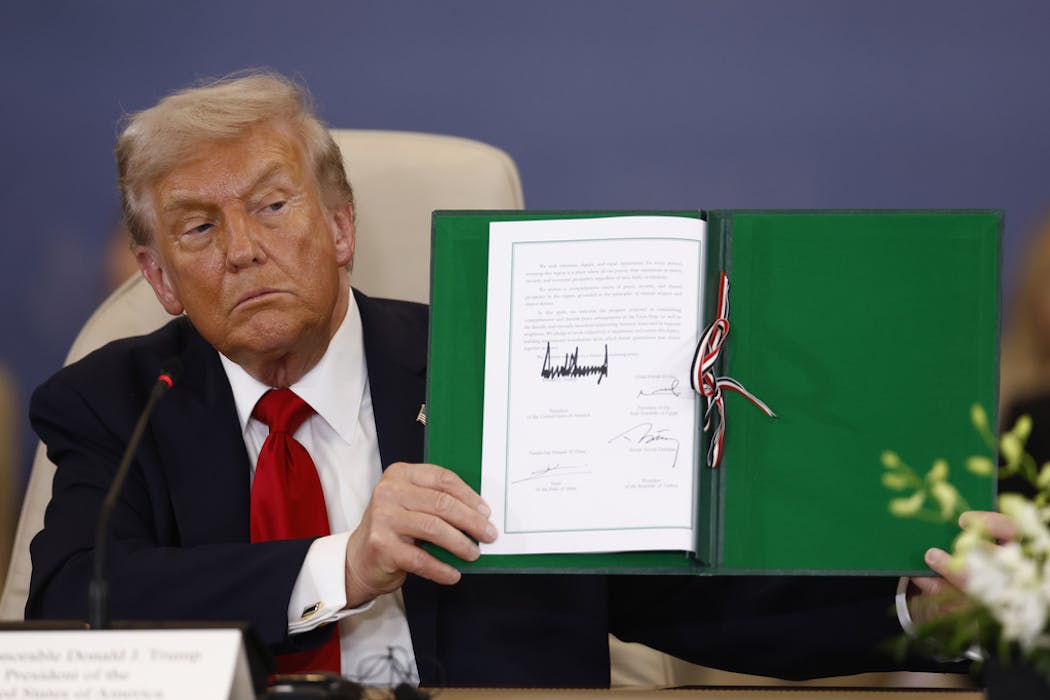Signature size and narcissism − a psychologist explains a long-ago discovery that helped establish the link
- Written by Richie Zweigenhaft, Emeritus Professor of Psychology, Guilford College

For years, Donald Trump’s distinctive, large and bold signature has captured the public’s attention. Not only did it recently come to light[1] that his signature appeared in a book that Jeffrey Epstein received for his 50th birthday, but it fits neatly alongside Trump’s long history of brash self-adulation. “I love my signature, I really do,” he said in a Sept. 30, 2025, speech to military leaders[2]. “Everyone loves my signature.”
His signature also happens to be of particular interest to me, given my decades-long fascination with, and occasional academic research on, the connection between signature size and personal attributes.
A long-time social psychologist[3] who has studied America’s elite, I made an unintentional empirical discovery as an undergraduate more than 50 years ago. The link that I found then – and that numerous studies have since echoed – is that signature size is related to status and one’s sense of self.
Signature size and self-esteem
Back in 1967, during my senior year of college, I was a work-study student in Wesleyan University’s psychology library. My task, four nights a week, was to check out books and to reshelve books that had been returned.
When students or faculty took books out, they were asked to sign their names on an orange, unlined card found in each book.
At some point, I noticed a pattern: When faculty signed the books out, they used a lot of space to sign their names. When students checked them out, they used very little space, leaving a lot of space for future readers.
So I decided to study my observation systematically.
I gathered at least 10 signatures for each faculty member and comparison samples of student signatures with the same number of letters in their names. After measuring by multiplying the height versus the width of the amount of space used, I found that eight of the nine faculty members used significantly more space[4] to sign their names.
In order to test for age as well as status, I did another study in which I compared the signatures of blue-collar workers such as custodians and groundskeepers who worked at the school with a sample of professors and a sample of students – again matched for the number of letters, this time on blank 3-by-5-inch cards. The blue-collar workers used more space than the students but less than the faculty. I concluded that age was at play, but so was status.
When I told psychologist Karl Scheibe, my favorite teacher, about my findings, he said I could measure the signatures in his books, which he had been signing for more than a decade since his freshman year in college.
As can be seen in the graph, his book signatures mostly got bigger. They took a major leap in size from his junior year to his senior year, dipped a bit when he entered graduate school and then increased in size as he completed his Ph.D. and joined the Wesleyan faculty.
References
- ^ only did it recently come to light (www.nytimes.com)
- ^ said in a Sept. 30, 2025, speech to military leaders (rollcall.com)
- ^ social psychologist (scholar.google.com)
- ^ used significantly more space (doi.org)
- ^ did a few (doi.org)
- ^ more studies (doi.org)
- ^ termed “status awareness (doi.org)
- ^ including in Iran (doi.org)
- ^ included a book about the CEOs of Fortune 500 companies (doi.org)
- ^ run an interview with Nick Seybert (hbr.org)
- ^ signature size and narcissism (doi.org)
- ^ a widely used 16-item narcissism scale (psytests.org)
- ^ found the same significant, positive correlation (doi.org)
- ^ use signature size to assess narcissism in CEOs (doi.org)
- ^ Journal of Management publish an article (doi.org)
- ^ explore narcissism in CEOs (doi.org)
- ^ other senior corporate positions such as chief financial officers (doi.org)
- ^ the United Kingdom (doi.org)
- ^ Germany (doi.org)
- ^ Uruguay (doi.org)
- ^ Iran (qjfep.ir)
- ^ South Africa (doi.org)
- ^ China (doi.org)
- ^ generated more than twice as much revenue (doi.org)
- ^ that many argue (www.theguardian.com)
Authors: Richie Zweigenhaft, Emeritus Professor of Psychology, Guilford College


